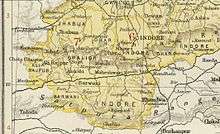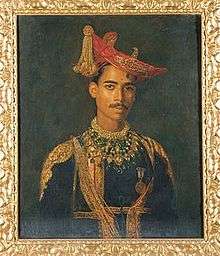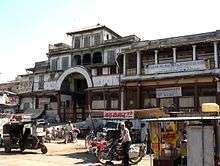Dhar State
Dhar State was a princely state of British Raj. It was a salute state in the colonial sway of the Central India Agency. Dhar began as one of the states during Maratha dominance in India about 1730. In 1941 it had an area of 1,798 square miles (4,660 km2) and a population of 253,210. Dhar(anagar) was the capital of the state since 1732 (from the 1728 foundation, the Raja's first seat had been Multhan). In 1948 it became part of Madhya Bharat.
| Dhar State धार रियासत | |||||||
|---|---|---|---|---|---|---|---|
| Princely State of British India | |||||||
| 1730–1947 | |||||||
 Flag | |||||||
 Dhar State in the Imperial Gazetteer of India | |||||||
| Area | |||||||
• 1941 | 4,660 km2 (1,800 sq mi) | ||||||
| Population | |||||||
• 1941 | 253,210 | ||||||
| History | |||||||
• Established | 1730 | ||||||
• Independence of India | 1947 | ||||||
| |||||||
| Today part of | India | ||||||
| Columbia-Lippincott Gazetteer (New York: Columbia University Press, 1952) p. 510 | |||||||


Lying between 21°57' and 23°15' north, and 74°37' and 75°37' east, Dhar State was bordered on the north by Ratlam State and Sailana State; east by parts of Gwalior and Indore States; on the south by Barwani State, and on the west by Jhabua State and portions of Gwalior and Indore.
Hemendra Singh Rao Pawar is the present head of the former ruling family of Dhar.[1][2][3][4][5]
History
The present Dhar dynasty was founded in 1729 by Udaji Rao Puar, a distinguished Maratha general who received the territory as a grant from the Chatrapati. During the Pindhari raids, the state's territory was whittled away, until it was restored in size on 10 January 1819, when it signed a Subsidiary alliance agreement with the British East India Company and became a major Princely state, enjoying indirect rule under British protectorate.
Rulers
The British granted Dhar a Hereditary gun salute of 15-guns.
Rajas
| Reign start | Reign end | Name | Birth-death |
|---|---|---|---|
| 1728 | 1732 | Udaji Raje I Pawar | |
| 1732 | 1736 | Anand Raje I Pawar | (b. ... – died 1749) |
| 1736 | 1761, 6 January | Yeshwant Raje I Pawar | (1724–1761) |
| 1761, 6 January | 1782 | Khande Raje Pawar | (b. c.1758 – died 1782) |
| 1782 | 1807, 10 June | Anand Raje II Pawar | (1782–1807) |
| 1807, Dec | 1810 | Ramchandra Raje I Pawar | (1807–1810) |
| 1807, Dec | 1810 | Maina Bai (f) (regent) | |
| 1810 | 1833, October | Ramchandra Raje II Pawar | (1805–1833) |
| 1834, 21 April | 1857, 23 May | Yeshwant Raje II Pawar | (1823–1857) |
| 1857, 23 May | 1858, 19 Jan | Anand Raje III Pawar (1st time) | (1844–1898) |
| 1858, 19 Jan | 1860, 1 May | state abolished | |
| 1860, 1 May | 1898, 29 July | Anand Raje III Pawar (2nd time) | (1844–1898) |
| 1898, 29 July | 1926 | Udaji Raje II Pawar "Baba Sahib" | (1886–1926) |
| 1926 | 1989 | Anand Raje IV Pawar | (1920–1989) |
| 1926 | 1931 | Laxmibai Sahiba (f) (regent) | |
Postal/Philatelic Information
In 1897 primitive stamps with entirely native text. The second definitive issue bore the name DHAR STATE in Latin script; a total of 8 stamps. Since 1901 Indian stamps have been in use.
See also
References
- "Hemendra Singh Puar is head of erstwhile princely state of Dhar". 15 January 2015.
- "Hemendra Puar to be new Dhar maharaja - Times of India".
- "404 Page not found…". freepressjournal.in. Archived from the original on 25 July 2015. Retrieved 7 September 2017.
- "Administration to remove seal on Dhar royal estates on HC orders - Times of India".
- Solomon, R. V.; Bond, J. W. (7 September 2017). "Indian States: A Biographical, Historical, and Administrative Survey". Asian Educational Services – via Google Books.
External links
